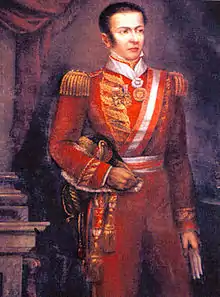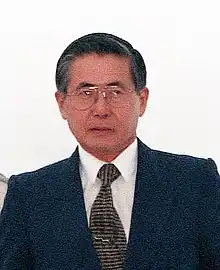Vacancy due to moral incapacity (Peru)
The vacancy of the Presidency of the Republic of Peru by declaration of permanent moral incapacity is one of the cases of vacancy of the Head of State contemplated in article 113 of the Constitution of Peru, whose origin dates back to the Political Constitution of Peru of 1839.[1]
The process is different from an impeachment (contemplated in article 99 of the Constitution only for the offenses established in article 117), since it occurs from a declaration' of the Congress of the Republic, which, if approved, creates a power vacuum, for which the legal succession proceeds . Said declaration of moral incapacity, regulated as Political Control in the Regulations of the Congress of the Republic, is considered by the Peruvian constitutional doctrine as a political trial sui generis.[2] More recently, the broad scope of the procedure has given the Congress of Peru power over the executive branch, allowing the legislature to remove the president without cause.[3][4]
Procedure
The declaration of the permanent moral incapacity of the President, corresponds to the Congress of the Republic, for which the following procedure established in the Regulations of the Congress:
The procedure for requesting a vacancy from the Presidency of the Republic, for the reasons set forth in subsection 2) of article 113 of the Constitution, is carried out in accordance with the following rules:
a) The vacancy request is formulated by means of a motion on the agenda, signed by no less than twenty percent of the legal number of Congressmen, specifying the factual and legal grounds on which it is based, as well as the documents that accredit it, or, failing that, the indication of the place where said documents are located. It takes precedence on the Agenda and is seen before any other pending motion on the agenda. Once the request is received, a copy of the same is sent, as soon as possible, to the President of the Republic.
b) For the admission of the vacancy request, the vote of at least forty percent of the able-bodied Congressmen is required. Voting is inevitably carried out in the session following the one in which the motion was made.
c) The Plenary of Congress agrees on the day and time for the debate and vote on the vacancy request, a session that cannot be held before the third day following the vote on the admission of the request or after the tenth, unless four-fifths of the number Congressmen agree to a shorter term debate and vote immediately. If necessary, a special session is summoned for this purpose. The President of the Republic whose vacancy is the subject of the request may personally exercise his right of defense or be assisted by a lawyer, for up to sixty minutes.
d) The agreement that declares the vacancy of the Presidency of the Republic, for the reasons set forth in subparagraph 2) of article 113 of the Constitution, requires a qualified vote of not less than 2/3 of the legal number of members of Congress and is recorded in a Resolution of Congress.
e) The resolution declaring the vacancy is published in the official gazette within twenty-four hours after receipt of the transmission sent by the Congress. Failing that, the President of Congress orders that it be published in one of the newspapers with the largest national circulation, without prejudice to the responsibilities that may arise.
f) The resolution declaring the vacancy is in effect from the moment the vacancy is communicated to the President of the Council of Ministers or its publication is made, whichever comes first.”[5]
It is worth mentioning that until 2004 there was no procedure that clearly established the mode of application of the corresponding constitutional article, which is why the Judgment of the Constitutional Court No. 0006-2003-AI/TC [6] established as criteria that the removal of the president of the republic should only be approved with a qualified vote of at least two thirds of the legal number of congressmen, urging Congress to legislate on the matter in order to fill the legal vacuum that existed until then.[7] In response to this, through Legislative Resolution of Congress No. 030-2003-CR, article 89-A was introduced into the Regulations of Congress.
Uses
| Date | Picture | President | Result | Details |
|---|---|---|---|---|
| June 23, 1823 |  |
José de la Riva Agüero | Presidential Vacancy | In June, 38 of 69 deputies met, and with 27 votes in favor, the "exemption of the supreme command" was approved. It was alleged that the defeats suffered in the fighting in recent months showed that Riva Agüero was not fit to lead the country. |
| February 4, 1914 |  |
Guillermo Billinghurst | Presidential Vacancy | From the end of 1913, Billinghurst planned the dissolution of Congress; In parallel, the parliamentarians agreed to declare the moral incapacity to govern the destinies of Peru in a manifesto to the nation. However, the coup d'état by Óscar Benavides removed Billinghurst from power, after which Congress published the manifesto declaring the vacancy and accepted the formation of a Governing Board. |
| April 9, 1992 |  |
Alberto Fujimori | Presidential Vacancy not recognized by the Armed Forces. | After the self-coup of April 5, 1992, on April 9, 1992, the Congress unconstitutionally dissolved by Fujimori met at the home of the deputy from the Christian People's Party Lourdes Flores Nano (99 deputies and 36 senators) and declared the permanent moral incapacity of Alberto Fujimori and with it the vacancy of the Presidency of the Republic .[8] |
| November 21, 2000 |  |
Alberto Fujimori | Presidential Vacancy | On September 14, 2000, a video was released showing Montesinos bribing members of other parties to support Fujimori. Two days later, and after the appearance of new videos, Alberto Fujimori called for parliamentary and presidential elections in which he would not participate. On November 19, Fujimori resigned from his post via fax from Japan. However, on November 21, Congress did not accept his resignation and proceeded to remove him due to moral incapacity. |
| December 21, 2017 | .jpg.webp) |
Pedro Pablo Kuczynski | The presidential vacancy was not declared | First impeachment of Pedro Pablo Kuczynski
Suspicions of acts of corruption allegedly committed by Kuczynski when he was minister (2004-2006) |
| March 22, 2018 | .jpg.webp) |
Pedro Pablo Kuczynski | Before voting on the presidential vacancy, the president resigned | Second impeachment of Pedro Pablo Kuczynski
After the Kenjivideos Scandal, President Kuczynski resigned from the Presidency of the Republic before the Congress proceeded with the vote on the presidential vacancy.[9] |
| September 18, 2020 |  |
Martin Vizcarra | The presidential vacancy was not declared | First impeachment of Martín Vizcarra
Having not told the truth and obstructed investigations in congressional and criminal courts.[10] |
| November 9, 2020 |  |
Martin Vizcarra | Presidential Vacancy | Second impeachment and removal of Martín Vizcarra
The motion argued that Vizcarra "had repeatedly and permanently lied the country" about alleged acts of corruption committed when he was regional Governor of the Department of Moquegua.[11][12] |
| November 25, 2021 | .png.webp) |
Pedro Castillo | The admission to debate the presidential vacancy did not proceed | First impeachment of Pedro Castillo
Due to the naming of doubtful people and being involved in acts of corruption, vacancy argues.[13][14] |
| March 8, 2022 | .png.webp) |
Pedro Castillo | The presidential vacancy was not declared | Second impeachment of Pedro Castillo
Due to the contradictions and alleged lies in court investigations, such as the alleged irregular promotions in the Armed Forces and the award of the Puente Tarata project to a company linked to the lobbyist Karelim López.[15] |
| December 7, 2022 | .png.webp) |
Pedro Castillo | Presidential Vacancy | Third impeachment of Pedro Castillo
Due to the signs of corruption and the tax files that accuse him of being the leader of a criminal organization, influence peddling and collusion.[16] Additionally , just hours before Castillo was meant to go to the Congress for his defense, he illegally announced[17] the dissolution of Congress and other unconstitutional measures ; action that caused Congress to vote in favor of the vacancy. Castillo was consequently arrested for attempting to break the constitutional order.[18] |
References
- Lionel Bardales del Aguila (2022). "Análisis interpretativo sobre la vacancia presidencial por incapacidad moral en el Perú". Revista Científica Ratio Iure. 2 (1): e276. doi:10.51252/rcri.v2i1.276.
- García Belaunde (2022) [2018]. El juicio político en la encrucijada. Vacancia y renuncia presidencial en el Perú.
- Asensio, Raúl; Camacho, Gabriela; González, Natalia; Grompone, Romeo; Pajuelo Teves, Ramón; Peña Jimenez, Omayra; Moscoso, Macarena; Vásquez, Yerel; Sosa Villagarcia, Paolo (August 2021). El Profe: Cómo Pedro Castillo se convirtió en presidente del Perú y qué pasará a continuación (in Spanish) (1 ed.). Lima, Peru: Institute of Peruvian Studies. p. 92. ISBN 978-612-326-084-2. Retrieved 17 November 2021.
- Taj, Mitra (2021-12-07). "'Too many mistakes': Peru's president threatened with impeachment after shaky start". Financial Times. Retrieved 2021-12-13.
- congreso.gob.pe (2014). "Reglamento del Congreso de la República" (PDF).
- tc.gob.pe (2004). "Sentencia del Tribunal Constitucional N° 0006-2003-AI/TC".
- Abraham Garcia Chavarri. "La incapacidad moral como causal de vacancia presidencial en el sistema constitucional peruano".
- "135 diputados peruanos eligen en la clandestinidad a un nuevo presidente". Diario el País. April 10, 1992. Retrieved December 25, 2022.
- "El Congreso de Perú debate la aceptación de la renuncia del presidente Pedro Pablo Kuczynski". BBC News. March 23, 2018. Retrieved December 25, 2022.
- "Moción de Vacancia" (PDF).
- "El Congreso de Perú destituye al presidente Vizcarra". BBC News. November 10, 2020.
- "Diario Oficial el Peruano". November 9, 2020.
- "Moción de vacancia presidencial contra Pedro Castillo: cómo es el procedimiento y qué podría pasar". Diario AS. 27 November 2021.
- "Congreso de Perú presenta oficialmente moción de vacancia contra Pedro Castillo". Bloomberg. 25 November 2021. Retrieved December 25, 2022.
- "Congreso admitió a debate la moción de vacancia contra Pedro Castillo". Diario Gestión. 14 March 2022. Retrieved December 25, 2022.
- "Congreso aprobó admitir a debate la moción de vacancia presidencial contra Pedro Castillo". Radio Programas del Perú. December 2022.
- "Golpe de Estado: Pedro Castillo anuncia disolución del Congreso e instaura un "gobierno de excepción"". Radio Programas del Perú. 7 December 2022. Retrieved December 25, 2022.
- "Pedro Castillo fue detenido y trasladado a la sede de la Prefectura tras autogolpe". InfoBae. Retrieved December 25, 2022.